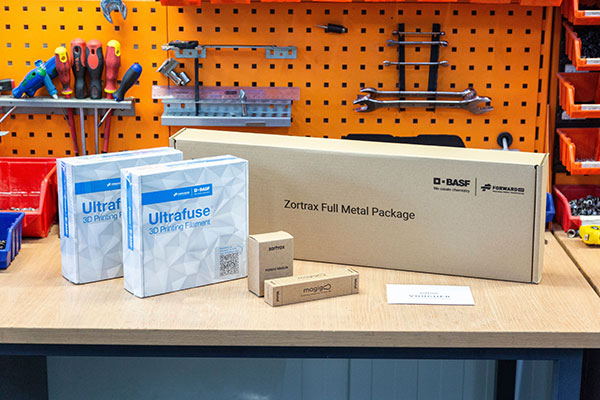Zortrax Launches Metal Printing for Desktop M300 Dual
This industrial-grade large workspace machine, working in single- and dual-extrusion modes, is compatible with a broad selection of materials, company reports.

Zortrax Full Metal Package kits contain essentials to desktop metal 3D printing, including metal-polymer filaments by BASF Forward AM: BASF Ultrafuse 316L and BASF Ultrafuse 17-4. Image courtesy of Zortrax and BASF.
Latest News
May 30, 2023
Zortrax is introducing metal 3D printing option for a desktop M300 Dual 3D printer. This industrial-grade large workspace machine, working in single- and dual-extrusion modes, is compatible with a broad selection of materials starting from basic, economical filaments and flexible materials through engineering classics like Nylon, to highly specialized, carbon- and glass- reinforced polymers for advanced technical applications. This range is expanded more with two kits: Zortrax Full Metal Package 316L and Zortrax Full Metal Package 17-4 PH.
Both sets contain all the essentials to desktop metal 3D printing, including metal-polymer filaments by BASF Forward AM: BASF Ultrafuse 316L and BASF Ultrafuse 17-4.
Zortrax M300 Dual is a desktop 3D printer supports filaments starting from standard ABS or PLA-based materials, and flexible filaments, through advanced composites reinforced with glass or carbon fiber like BASF Ultrafuse PPGF 30 or BASF Ultrafuse PAHT CF15 to engineering classics like Nylon or Nylon-based materials. The printing profiles available in Z-SUITE software for the M300 Dual include filaments made by brands like BASF Forward AM, Nanovia, KIMYA or 3DxTech. This means that Zortrax M300 Dual 3D printer can work with nearly all filaments and deals with most applications in most industries.
“Zortrax M300 Dual is a truly universal machine, which combines a large workspace, single- and dual-extrusion modes, intuitive interface, and a very wide range of ready-to-use, calibrated material profiles. We’re now adding an option of metal 3D printing to this desktop printer with two comprehensive sets: Zortrax Full Metal Package 316L and Zortrax Full Metal Package 17-4 PH, encompassing everything that’s necessary to start metal 3D printing and to ensure fully functional metal parts, which exhibit the properties of steel,” says Michał Siemaszko, head of Research and Development Department at Zortrax.
Zortrax Full Metal Package 316L and Zortrax Full Metal Package 17-4 PH, apart from a metal-polymer filament, both include all other components needed for metal 3D printing. In each package, the users will find: BASF Ultrafuse Support Layer, a support material, ensuring the desired geometry of the printed parts during the 3D printing and post-processing stages, Magigoo Pro Metal adhesive to provide adhesion during printing and removal of the printed part, an extra hotend module for Zortrax M300 Dual, an adapter with a PTFE tube, and a voucher for professional post-processing in Elnik company (BASF’s trusted partner in Germany), where 3D prints undergo sintering and debinding processes to achieve steel properties.
The introduction of the new metal printing option for M300 Dual is accompanied by several improvements to the Z-SUITE slicer in BETA version 3.2.0. The latest update makes the software more aligned with the needs of the 3D printers’ user base and the nature of the two-stage post-processing that turns “green” parts into steel. Notable features in this area include a new gyroid infill, the way support structures are 3D printed with BASF Ultrafuse Support Layer, and that the update brings new materials and performance improvements for all Zortrax 3D printers.
“The latest version of Z-SUITE BETA features a set of improvements in printing with metallic powder filaments. A new gyroid infill enables printing metal models with 60% to 90% infill. Another change enhances the way in which support structures are printed with BASF Ultrafuse Support Layer. Here, supports are divided into smaller blocks along all axes and narrowed down towards the bottom. All this makes supports placed in the areas that are difficult to reach easier to remove and reduces their footprint on the model,” says Ewa Piórkowska, R&D software project manager at Zortrax.
Discover Zortrax M300 Dual 3D printer, Zortrax Full Metal Package 316L and Zortrax Full Metal Package 17-4 PH. Learn more about desktop metal 3D printing capabilities on Zortrax blog.
Sources: Press materials received from the company and additional information gleaned from the company’s website.
Subscribe to our FREE magazine, FREE email newsletters or both!
Latest News
About the Author
DE’s editors contribute news and new product announcements to Digital Engineering.
Press releases may be sent to them via [email protected].





